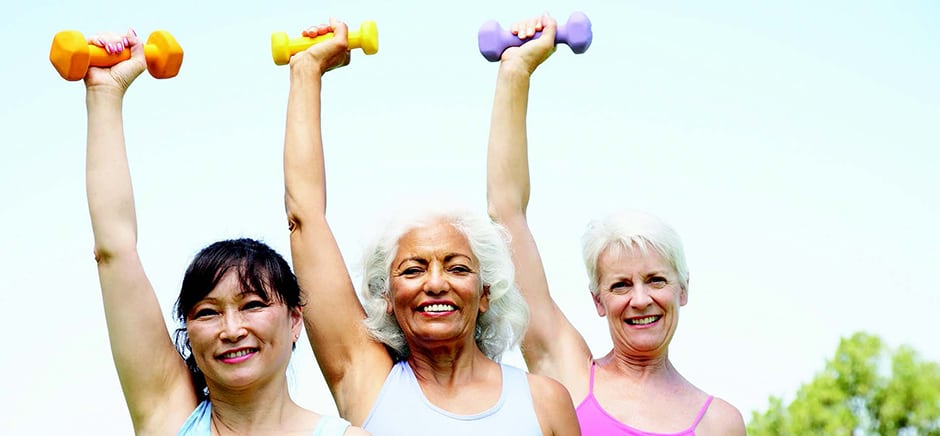
[This piece was written by Lara Habura, OTR/L, supervisor of Physical Rehabilitation, Clifton Park, part of St. Peter’s Health Partners Patient Therapies.]
Performing everyday activities such as cleaning the house, carrying groceries, opening up jars, and yard and garden care all require strength, balance and coordination. If you have difficulty performing these general types of activities, the solution could lie in a general, light strength training program.
According to the American Journal of Preventive Medicine, numerous studies have revealed older adults who engaged in strength training on a regular basis reported improved ability to perform general activities of daily living. This included climbing stairs, getting dressed, getting up and down off the floor, and continuing favorite activities such as golf or tennis.
It’s easy to get started, but if you have a history of high blood pressure, heart disease or joint problems, please consult your primary health care provider before you start any new exercise program.
Other things to consider before you begin:
- Exercise with a friend. It’s often easier to stick to a routine when you do it with a partner.
- Consider attending an exercise class that uses weights or strength training calisthenics at a local community center or high school.
- Consult an occupational or physical therapist who can set up an appropriate program specifically for you.
- Join a local health club or the YMCA and get suggestions from the licensed trainers.
No matter what option you choose, start now and have fun! You’ll be surprised at how quickly you notice the benefits.
Always warm up before beginning exercises to help avoid injury. Warm up should include about five to ten minutes of light aerobic activity such as brisk walking and then some gentle stretching.
Usually, it is best to start with a weight that can be felt but isn’t too fatiguing. Investing in weights that are between 1 to 3 pounds is a good start. You should be able to complete 5 to 6 repetitions before feeling fatigued. Ideally, you should be able to perform 8 to 10 repetitions while maintaining good posture but you should feel the need to rest afterwards.
Stop any exercise that causes pain. However, do not be surprised if your muscles are a little sore for 24-72 hours after performing your first few workouts.
Remember to breathe! Try to exhale when you lift and inhale as you lower the weight down. Keep your grip relaxed.
Always end your workout with a five to ten minute cool down. The cool down can be a lighter version of your warm up and stretch.
Ultimately, when it comes to being more physically active, remember that something is always better than nothing. Make this the summer where you commit to improving your healthy habits and add a little strength training into the mix!
St. Peter’s Health Partners Patient Therapies has a variety of outpatient occupational and physical therapists at locations throughout the Capital District, accepting all insurances and providing quality one-on-one treatment. For information, please call 518-525-5211.
Basic Strength Training Exercises You Can Do at Home
Seated Overhead Press: Sit upright on the edge of a chair with your feet flat on the floor and about shoulder width apart. Hold a weight in each hand with the arms bent, palms facing forward close to the sides of your upper chest. Slowly press the weights straight up but don’t lock your elbows. Then slowly lower back to starting position. You can also do this one arm at a time. Be sure you exercise each arm before counting a repetition.
Standing Bicep Curls: Stand upright with the knees slightly bent. Arms should be against your side with palms facing toward your thighs. Raise the weight toward your shoulder by bringing the forearm up and slowing rotating the forearm until the palm faces your body/thumb facing toward the outside of your body and then return to start position. You can do this with both arms or just one at a time.
Sitting Push Ups: Sit in a chair with arms. Sit up straight on the edge of the chair with feet about shoulder width apart. Palms should grip the arms of the chair. Push down into the arms of the chair and slowly raise your body up about three to four inches, letting your legs assist as needed and then slowly return to beginning position.
Wide Leg Squat: Place a chair against a wall so it will not move. Stand about 6-7 inches in front of the chair with your back facing the chair. Your feet should be a little wider than shoulder width apart. Try to keep your arms crossed on your chest or straight out in front of you. Slowly sit toward the chair, leaning forward from the hip and keeping your spine in a straight line. Try to control the speed on the descent toward the chair and don’t let your knees go beyond your toes. Pause, then lean forward, shoulders over hips, and slowly return to standing.
Abdominal Exercise: Lie on your back with your knees bent and your feet flat on the floor. Your feet should be about shoulder width apart. Press the small of your back against the floor and contract your abdominal muscles, tilting your pelvis toward your shoulders. Your bottom should come up only an inch or two off the floor. Hold for five seconds and then relax.





